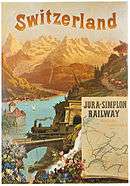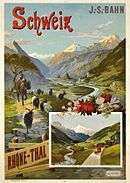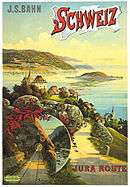Jura–Simplon Railways
The Jura–Simplon Railways (JS), (French: Compagnie des Chemins de Fer Jura–Simplon[2]) was a railway company that was formed in 1890. It was nationalised in 1903 as the largest railway company in Switzerland and integrated into the Swiss Federal Railways (SBB).
| Jura–Simplon Railways | ||||||||||||||||||||||||||||||||||||||||||||||||||||||||||||||||||||||||||||||||||||||||||||||||||||||||||||||||||||||||||||||||||||||||||||||||||||||||||||||||||||||||||||||||||||||||||||||||||||||||||||||||||||||||||||||||||||||||||||
|---|---|---|---|---|---|---|---|---|---|---|---|---|---|---|---|---|---|---|---|---|---|---|---|---|---|---|---|---|---|---|---|---|---|---|---|---|---|---|---|---|---|---|---|---|---|---|---|---|---|---|---|---|---|---|---|---|---|---|---|---|---|---|---|---|---|---|---|---|---|---|---|---|---|---|---|---|---|---|---|---|---|---|---|---|---|---|---|---|---|---|---|---|---|---|---|---|---|---|---|---|---|---|---|---|---|---|---|---|---|---|---|---|---|---|---|---|---|---|---|---|---|---|---|---|---|---|---|---|---|---|---|---|---|---|---|---|---|---|---|---|---|---|---|---|---|---|---|---|---|---|---|---|---|---|---|---|---|---|---|---|---|---|---|---|---|---|---|---|---|---|---|---|---|---|---|---|---|---|---|---|---|---|---|---|---|---|---|---|---|---|---|---|---|---|---|---|---|---|---|---|---|---|---|---|---|---|---|---|---|---|---|---|---|---|---|---|---|---|---|---|---|---|---|---|---|---|---|---|---|---|---|---|---|---|---|---|
| Operation | ||||||||||||||||||||||||||||||||||||||||||||||||||||||||||||||||||||||||||||||||||||||||||||||||||||||||||||||||||||||||||||||||||||||||||||||||||||||||||||||||||||||||||||||||||||||||||||||||||||||||||||||||||||||||||||||||||||||||||||
| Opened | merger 1890 | |||||||||||||||||||||||||||||||||||||||||||||||||||||||||||||||||||||||||||||||||||||||||||||||||||||||||||||||||||||||||||||||||||||||||||||||||||||||||||||||||||||||||||||||||||||||||||||||||||||||||||||||||||||||||||||||||||||||||||
| Closed | to SBB 1903 | |||||||||||||||||||||||||||||||||||||||||||||||||||||||||||||||||||||||||||||||||||||||||||||||||||||||||||||||||||||||||||||||||||||||||||||||||||||||||||||||||||||||||||||||||||||||||||||||||||||||||||||||||||||||||||||||||||||||||||
| Technical | ||||||||||||||||||||||||||||||||||||||||||||||||||||||||||||||||||||||||||||||||||||||||||||||||||||||||||||||||||||||||||||||||||||||||||||||||||||||||||||||||||||||||||||||||||||||||||||||||||||||||||||||||||||||||||||||||||||||||||||
| Track gauge | 1,435 mm (4 ft 8 1⁄2 in) standard gauge[1] | |||||||||||||||||||||||||||||||||||||||||||||||||||||||||||||||||||||||||||||||||||||||||||||||||||||||||||||||||||||||||||||||||||||||||||||||||||||||||||||||||||||||||||||||||||||||||||||||||||||||||||||||||||||||||||||||||||||||||||
| ||||||||||||||||||||||||||||||||||||||||||||||||||||||||||||||||||||||||||||||||||||||||||||||||||||||||||||||||||||||||||||||||||||||||||||||||||||||||||||||||||||||||||||||||||||||||||||||||||||||||||||||||||||||||||||||||||||||||||||
History
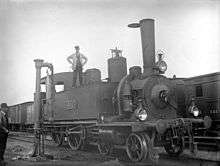
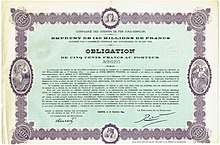
The Jura–Simplon Railways was a railway company, which was formed from the 1890 merger of the two most important western Swiss railway companies, the Jura–Bern–Lucerne Railway (JBL), including the Gümligen–Lucerne line belonging to the canton of Bern, and the Western Swiss Railways (Chemins de fer de la Suisse Occidentale; SOS). The Federal Government also participated in the merger by means of a voluntary share purchase. The Pont–Vallorbe Railway (Chemin de fer Pont–Vallorbe), operated by the SOS, was purchased on 1 January 1891.
The share capital of the new company was formed of Swiss francs (CHF) 52 million of preferred stock and CHF 34 million of common stock. The preferred shares comprised 38 million existing JBL shares and 14 million SOS shares. The nominal value of an SOS ordinary share was reduced from CHF 500 to 200 and the amount of CHF 52.4 million exempted from the stock reconstruction was applied to depreciation. The Swiss government was given the right to repurchase the JS.
Construction of the Simplon Tunnel
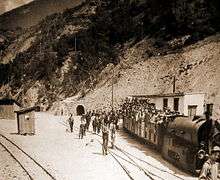

Although the Jura-Simplon Railway was a railway company for only 13 years, it helped break the impasse over the building of the Simplon Tunnel from Brig to Iselle in Italy after decades of effort by Bern and Romandy. Studies prepared to support the construction of the tunnel had already been submitted by the SOS to the federal and cantonal authorities. In 1891, JS, as a new entrepreneurial railway company, presented the Federal Council with a definitive project for the Simplon Tunnel.
On 25 November 1895, a treaty was signed with Italy for the construction of what would be the longest tunnel in the world. The construction costs for the single-track tunnel were estimated at CHF 58,820,000. The treaty obliged Switzerland to provide funding of CHF 15 million and Italy to provide funding of CHF 4 million. Italy was represented by four directors on the JS board. Construction began on the 19,803-metre-long tunnel in 1898. The tunnel was the longest railway tunnel in the world[3] until the opening of the Seikan Tunnel in 1988.
Operations
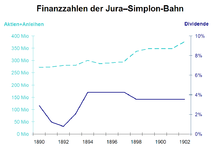
The Jura–Simplon Railways operated several other railway lines:
- Jougne–Vallorbe–Pontarlier line and Verrières–Pontarlier line of the French Chemins de fer de Paris à Lyon et à la Méditerranée (PLM)
- Bière–Apples–Morges railway (BAM)
- Bödelibahn (BB; from 1895)
- Bulle–Romont railway (BR)
- Cossonay–Gare–Ville funicular (CG)
- Fribourg–Ins railway (Chemin de fer Friborg-Morat-Anet, FMA)
- Neuchâtel–Le Locle-Col-des-Roches railway (Jura neuchâtelois; JN)
- Pont–Brassus Railway (PBr)
- Pont–Vallorbe Railway (PV)
- Travers–Buttes railway (Régional du Val-de-Travers; RVT)
- Spiez-Erlenbach Railway (SEB)
- Lake Thun Railway (Thunerseebahn; TSB)
- Visp-Zermatt Railway (VZ)
- Yverdon–Ste-Croix railway (YSteC)
On 14 June 1891, the Jura–Simplon Railways suffered the Münchenstein rail disaster, the worst railway accident in Swiss history. The railway bridge over the Birs, which was built by Gustave Eiffel, collapsed below the village of Münchenstein under a train from Basel. Three carriages and the two locomotives crashed into the flooded Birs. 78 people were killed and 131 were injured. A soldier died of injuries sustained during the cleanup. The accident led to a stricter supervision of the railways. The railway bridges were systematically examined and the first building standards were created.[4]
In the Zollikofen train crash on 17 August 1891 in Zollikofen, a Bern–Paris express ran into an "extra" (not listed in the timetable) train waiting at a red home signal. The impact killed 14 passengers and injured 122 on the extra train. The accident was caused by mistakes at various operating points. The express has been released to run through an occupied section. A deactivated air brake also reduced the braking effect.[5][6]
Despite investing in the construction of the Simplon tunnel, JS was able to pay a dividend every year.
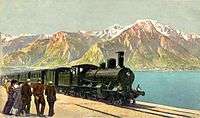 Train hauled by a B 3/4 on the shores of Lake Geneva with the Savoy Alps in the background.
Train hauled by a B 3/4 on the shores of Lake Geneva with the Savoy Alps in the background.- Two officers of the JS in the office of Kaiserstuhl station.
- "Water train" in Bussigny station
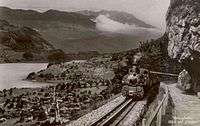
Posters
Thee Jura-Simplon Railway advertised with a series of posters. Some of them were designed by Hugo d’Alési.
Nationalisation
During the construction of the Simplon tunnel, the national referendum of 20 February 1898 agreed to the nationalisation the Jura-Simplon railway and the other four main railways. The Jura-Simplon Railway was taken over by the Swiss Federal Railways (SBB) on 1 May 1903 and it completed the Simplon Tunnel in 1906.
Graphic summary
Overview of the history of the Jura–Simplon Railways (T: takeover):
| → Predecessor railways of the SOS | → Predecessor railways of the JB | ||||||||||||||||||||||||||||||||||||
| Western Switzerland- Simplon (SOS) T: 1.1.1890 | Jura-Bern-Lucerne (JBL) inc. Gümligen–Lucerne T: 1.1.1890 | Pont–Vallorbe (PV) T: 1.1.1891 | |||||||||||||||||||||||||||||||||||
| Swiss Central Railway (SCB)[note 1] T: 1.1.1902 | Swiss Northeastern Railway (NOB)[note 1] T: 1.1.1902 | United Swiss Railways (VSB) T: 1.7.1902 | Jura–Simplon Railways (JS) T: 1.5.1903 | Gotthard Railway (GB) T: 1.5.1909 | |||||||||||||||||||||||||||||||||
| Swiss Federal Railways (SBB) | |||||||||||||||||||||||||||||||||||||
Infrastructure and vehicles
Stations
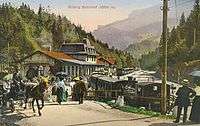 Brünig station around 1900
Brünig station around 1900- Bussigny station around 1905, with B 3/4 of the former JS
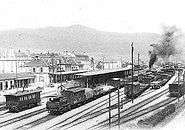 Delémont station around 1897
Delémont station around 1897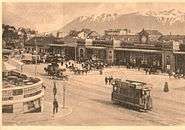 Lausanne station around 1898
Lausanne station around 1898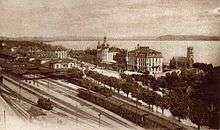 Neuchâtel station around 1897
Neuchâtel station around 1897 Sarnen station of the Brünig Railway around 1910
Sarnen station of the Brünig Railway around 1910- Vevey station before its extension shortly after 1900
The stations of Basel, Bern and Lucerne of the Central Railway (SCB) and Geneva of the Paris-Lyon-Mediterranean (PLM) were shared by the Jura-Simplon Railway.
Network
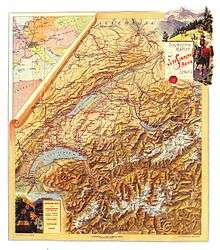
The route network of 937 km ran from Basel, Geneva and the Jura border crossings of Delle, La Chaux-de-Fonds, Les Verrières and Vallorbe to Brig and Lucerne. In addition, the narrow-gauge Brünig Railway from Lucerne to Brienz was part of the 937 km-long route network. It consisted of the combined lines of its predecessor railways:
- the lines of the Jura-Bern-Lucerne
- the lines of the Western Swiss Railways
- the Pont–Vallorbe Railway
Duplication
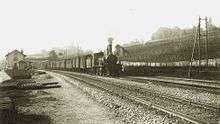
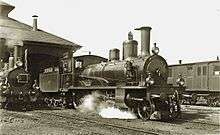
The Jura-Simplon Railway continued the track duplication of its predecessors. When SBB took over JS in 1903, 131.20 km (14%) of the network was duplicated.
| Railway line | Section | Double track opened on |
|---|---|---|
| Lausanne–Biel | Lausanne–Renens VD | 5 May 1856 by Western Swiss |
| Renens VD–Bussigny | 1897 | |
| Bussigny–Cossonay | 21 August 1895 | |
| Cossonay–Daillens | 1 June 1896 | |
| Auvernier–Neuchâtel | 1 June 1898[note 2] | |
| Lausanne–Geneva | 1868–1879 by Western Swiss, Western Swiss-Simplon and LFB | |
| Lausanne–Bern | Lausanne–La Conversion | 1 May 1902 |
| Chexbres–Palézieux | ||
| Lausanne–Brig | Lausanne–Lutry | 1 June 1900 |
| Lutry–Cully | 1 June 1899 | |
| Cully–Rivaz | 1 October 1892 | |
| Rivaz–Montreux | 1 June 1892 | |
| Montreux–Villeneuve | 10 October 1891 | |
| Granges-Lens–Sierre | 24 June 1901 | |
| Bern–Biel | Lyss–Busswil[note 3] | 1877 by Bern-Lucerne-Bahn |
Rolling stock
The Jura-Simplon Railway named their rolling stock according to the then nationwide classification system.
The JS operated the following locomotives. The class name that was valid from 1902 is listed in brackets.
| Class | JS no. | SBB No.[note 4] from 1903 | Manufacturer | Build year | Scrapped | image |
|---|---|---|---|---|---|---|
| A2 (Ec 2/4) | 1–12 | – | Taken over in 1890 from the Bern-Lucerne Railway (BLB; see there) | 1888–1896 | ||
| A2 (Eb 2/4) | 13–16 | 5441–5442 | Taken over in 1890 from the Bernese Jura Railway (JBL; see there) | 1900–1917 | ||
| 17–32 | 5451–5476 | 1900–1947 | 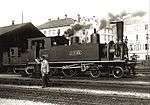 | |||
| 33–42 | Esslingen, SLM Winterthur | 1880–1892 | ||||
| A2T (B 2/3) | 51–63 | – | Taken over in 1890 from the Western Switzerland–Simplon Company (SOS; see there) | 1890–1902 | ||
| A2T (B 2/3) | 63–67 | – | 1892–1896 | |||
| A2T (B 2/3) | 69–73 | – | 1890–1892 | |||
| A2T (B 2/3) | 74–79 | 1074–1079 | 1904–1907 | |||
| A2T (B 2/3) | 80–82 | 1080–1082 | 1903 | |||
| A2T (A 2/4) | 101–130 | 101–130 | SLM Winterthur | 1892–1896 | 1917–1926 |  |
| A3T (B 3/4) | 201–204 | 1421–1424 | Taken over in 1890 from the SOS (see there) | 1917 | ||
| 205–212 | 1561–1568 | Taken over in 1890 from the JBL (see there) | 1924–1932 | |||
| 213–222 | 1569–1578 | SLM Winterthur | 1891 | 1912–1932 | ||
| A 3/5 | 231–232 | 701–702 | SLM Winterthur | 1902 | 1926–1964 | |
| (Nachbau SBB) | 703–811 | 1904–1909 | ||||
| B2 (Ec 2/4) | 251–262 | 6195–6199 | Taken over in 1890 from the Lausanne–Fribourg–Bern Railway (see there) | 1895–1905 | ||
| B2 (Ec 2/3) | 263–267 | 6398, 6399 | Taken over in 1890 from the SOS (see there) | 1909–1923 | ||
| A3T (B 3/4) | 301–375[note 5] | 1601–1675 | SLM Winterthur | 1896–1902 | 1923–1945 |  |
| (Nachbau SBB) | 1676–1747 | 1903–1907 | ||||
| B3T (C 3/3) | 401–416 | 2401–2403, 2406–2412, 2413 | Taken over in 1890 from the SOS (see there) | 1900–1911 | ||
| 417–419 | 2404, 2413 | 1898–1909 | ||||
| 421–424 | – | Taken over in 1890 from the BLB (see there) | 1898–1902 | |||
| 425–431 | 2405, 2415–2416 | Taken over in 1890 from the JBL (see there) | 1900–1911 | |||
| C3 (Ed 3/3) | 451–457 | 7291–7297 | Taken over in 1890 from the BLB (see there) | 1906–1916 | ||
| C3T (D 3/3) | 501–505 | 3351, 3368–3369, 3699 | Taken over in 1890 from the SOS (see there) | 1901–1913 | ||
| 506–508 | 3364, 3370–3371 | 1907–1913 | ||||
| 509–511 | 3372–3374 | 1909–1914 | ||||
| 512–519 | 3352–3353, 3375–3378, 3390 | 1897–1925 | ||||
| 520–539 | 3354–3359, 3363–3367, 3379–3386, 3389, 3391 | 1901–1925 | ||||
| 540 | 3387 | JS (Yverdon workshop) | 1892 | 1924 | ||
| 541–546 | 3360–3361, 3392–3393, 3399 | Taken over in 1890 from the JBL (see there) | 1904–1913 | |||
| 547–555 | 3362–3363, 3388, 3394–3398 | 1902–1917 | ||||
| 561–565 | 3421–3425 | SLM Winterthur | 1890 | 1916 | ||
| B3 (Ec 3/4)[note 6] | 601–612 | 6501–6512 | SLM Winterthur | 1901 | 1934–1955 |  |
| (Nachbau SBB) | 6513–6529 | 1904–1910 | 1933–1961 | |||
| E3 (E 3/3) | 751–752 | – | Taken over in 1891 from the Pont–Vallorbe Railway (see there) | 1924–1948 | ||
| F2 (E 2/3) | 801 | – | Taken over in 1890 from the SOS (see there) | 1891 | ||
| F3 (E 3/3) | 851–852 | 8571–8572 | Taken over in 1890 from the JBL (see there) | 1911–1913 | ||
| 853–856 | 8574–8576 | SLM Winterthur | 1890 | 1911–1916 | ||
| 857–866 | 8431–8440 | 1901 | 1947 | |||
| Locomotives of the narrow gauge Brünig Railway: | ||||||
| G2 (G 3/3) | 901–906 | 101–110 | Taken over in 1890 from the JBL (see there) | 1911–1916 |  | |
| 907–910 | SLM Winterthur | 1887–1901 | 1915–1942 | |||
| HG2 (HG 2/2) | 951–958 | 1001–1008 | Taken over in 1890 from the JBL (see there) | 1908–1911 | ||
| 959–963 | 1009–1013 | SLM Winterthur | 1894–1901 | 1911–1912 | ||
References
Notes
- Including the Aargau Southern Railway, the Bözberg Railway and the Wohlen–Bremgarten railway, which were owned jointly by the Central Railway and the Northeastern Railway.
- Neuchâtel-Vauseyon–Neuchâtel previously parallel tracks of the two lines to Lausanne and La Chaux-de-Fonds
- Shared section of the Bern–Lyss–Biel line of the JS and Lyss–Solothurn line of the Central Railway
- The SBB renumbered the locomotives taken over after the completion of boiler revisions.
- Locomotive No. 301 initially bore the company number 231.
- Locomotives 6513, 6515 and 6517–6529 were rebuilt from 1922 to 1928 in the SBB main workshops of Rorschach and Biel as Ec 3/5 6601–6615.
Footnotes
- "unknown". The Locomotive Magazine: 44. 17 January 1903.
- "Traité entre la Suisse et l'Italie pour la construction et l'exploitation d'un chemin de fer à travers le Simplon de Brigue à Domodossola" (PDF) (in French). Government of Switzerland. Retrieved 18 July 2019.
- Bärtschi 2011.
- "Das Eisenbahnunglück bei Mönchenstein". Schweizerische Bauzeitung (in German). 17 (25): 50. 1891. Archived from the original on 2018-01-29. Retrieved 2019-07-22.
- "Ueber das Eisenbahnunglück in Zollikofen bei Bern". Schweizerische Bauzeitung (in German). 18 (8): 50. 1891. Archived from the original on 2018-01-29. Retrieved 2019-07-22.
- "Eisenbahnunglück bei Zollikofen". Schweizerische Bauzeitung (in German). 18 (9): 54–55. 1891. Archived from the original on 2018-01-29. Retrieved 2019-07-22.
Sources
- Bärtschi, Hans-Peter (30 November 2011). Jura-Simplon-Bahn (JS) (in German). Retrieved 22 July 2019.
- Frey, Thomas; Schiedt, Hans-Ulrich. "Jura–Simplon". bahndaten.ch. Daten zu den Schweizer Eisenbahnen 1847–1920 (in German). ViaStoria. Retrieved 22 July 2019.
- Moser, Alfred (1967). Der Dampfbetrieb der Schweizerischen Eisenbahnen 1847–1966 (in German). Basel and Stuttgart: Birkhäuser Verlag.CS1 maint: ref=harv (link)
- Wägli, Hans G. (2010). Schienennetz Schweiz und Bahnprofil Schweiz CH+ (in German). Zürich: AS Verlag. ISBN 978-3-909111-74-9.CS1 maint: ref=harv (link)
- Weissenbach, Plazid (1913). Das Eisenbahnwesen der Schweiz (PDF 14.8 MB) (in German). p. 66. Retrieved 22 July 2019.
